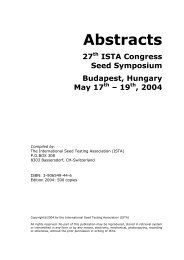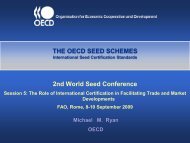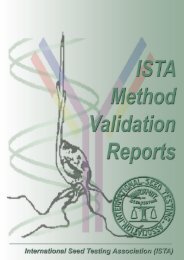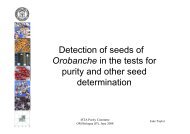Historical Paper - Volume 2 2008 - International Seed Testing ...
Historical Paper - Volume 2 2008 - International Seed Testing ...
Historical Paper - Volume 2 2008 - International Seed Testing ...
Create successful ePaper yourself
Turn your PDF publications into a flip-book with our unique Google optimized e-Paper software.
H.A. JENSEN<br />
chapter 13). Many of the early published papers included information for all three types<br />
of analyses (e.g. Grisch 1935).<br />
<strong>Seed</strong> collections, seed illustrations and descriptions of seed morphology have been<br />
valuable tools in the identification of unknown seeds. In 1977 a working group on<br />
identification of seeds was founded, which collected information on seed collections as<br />
well as on seed morphology (Jensen 1979a, 1979b, 1998b).<br />
8.1 <strong>Seed</strong> collections<br />
<strong>Seed</strong> collections, covering the crop and weed seeds tested in the laboratory as well as<br />
those occurring in the proficiency test samples submitted by ISTA, are very important<br />
tools for the seed identification.<br />
Many botanical gardens have supplied seeds to the seeds testing laboratories. Beautiful<br />
seed collections could be obtained from Hungary in the 1930’es, and seed collections<br />
have been offered for sale from the ISTA seed laboratory at Hohenheim, Germany and<br />
from Angers, France since around year 2000.<br />
The experience in how to establish and maintain seed collections was presented at<br />
ISTA Workshops in Wageningen 1978 (Jensen 1979d) and Budapest (Jensen 2000).<br />
The presentations covered different kind of seed collections, arrangements of seeds<br />
in collections, types of containers, control of insects and use and maintenance of seed<br />
collections.<br />
Preparing a universal list of weed species has been on the working programme for the<br />
Purity Committee since 2004, and the supply of such seeds and training in identification<br />
of weed and crop seeds are still important elements in the working programme for the<br />
Purity Committee in 2006.<br />
8.2 Illustrations and descriptions of seed morphology<br />
The Working Group on <strong>Seed</strong> Identification also collected information on handbooks and<br />
articles with illustrations and descriptions of seeds and fruits from all over the world. This<br />
information was published in a bibliography containing 3,775 references. The papers, all<br />
printed before 1990, contained descriptions of seed morphology of 3,900 genera (Jensen<br />
1998b). The morphology of the seeds was described by use of keys and illustrated by<br />
drawings, photos and pictures taken by electron scanning microscopes.<br />
Gunn and Seldin (1977) prepared seed and fruit characters for a computer identification<br />
and discussed five useful computer programmes.<br />
At the Budapest workshop, specific training was given in the use of botanical<br />
characters for identification of seeds (Leist 2000a), identification of seeds of Lathyrus<br />
and Vicia (Leist 2000b), Avena species and spontaneous crossings between them (Leist<br />
1981, 2000c), of the Brassicaceae family (Andersen and Skjödt 2000) and of Rumex and<br />
Silene seeds (Andersen and Jensen 2000).<br />
Bernard (1998) described the comparative seed morphology of five Lolium species<br />
growing in France, Marin et al. (1998) examined the seed sculpturing of selected Vicia<br />
species and Allison et al. (2001) the florets of Bromus riparius and the closely related<br />
Bromus inermis. In these papers keys, drawings and scanning electron pictures were used<br />
when describing differences between species.<br />
28

















